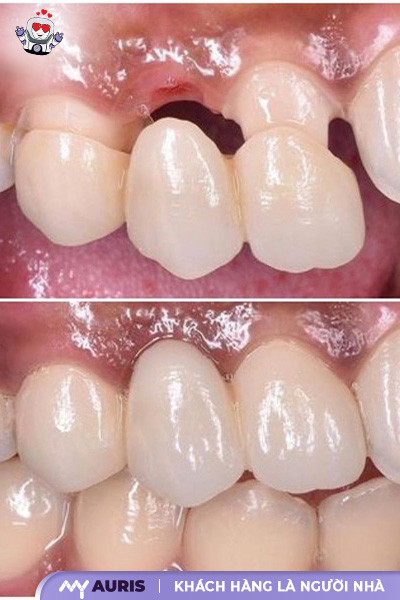Is porcelain veneering good? This is a common question for many people researching this cosmetic dental method. The direct intervention on natural teeth causes many to worry about durability and potential impact on oral health. So, is porcelain veneering durable? Are there any side effects? The answer depends on many factors such as material, technique, and post-veneering care. Let’s find out more with My Auris in the article below!
Is porcelain veneering good?
Porcelain veneering is a safe dental restoration method that helps replace damaged teeth and enhance dental aesthetics. Thanks to advanced technology, porcelain teeth not only restore chewing function but also bring a natural beauty, improving confidence in communication.
One of the prominent benefits of porcelain veneering is its high durability, lasting from 10 to 20 years, or even longer if properly cared for. According to dental studies, porcelain veneering has a high success rate, protects natural tooth tissue, prevents tooth decay, limits damage to original teeth, and maintains oral health.
Beyond aesthetics, porcelain veneering also helps improve chewing function, providing a comfortable feeling like natural teeth. Modern porcelain crowns, porcelain veneers, or fixed restorations offer customers many choices to suit their needs.

Should you get porcelain veneers, and who is a suitable candidate?
Porcelain veneering is a popular dental restoration method in cosmetic dentistry, providing a confident smile and effective tooth protection. When performed with the correct technique at a reputable dental clinic, you will receive the following benefits:
Improved dental aesthetics, making your smile more natural and attractive.
High durability of porcelain teeth, lasting long with proper care.
Resistance to teeth yellowing, limiting discoloration caused by food and drinks.
Improved chewing function, making teeth stronger and more effective.
Protection of tooth pulp and root, reducing the risk of tooth weakening or damage.
Porcelain veneering is suitable for the following cases:
Teeth severely stained by antibiotics, unable to be whitened.
Teeth previously covered with composite but experiencing gum recession.
Severe gingivitis leading to weakened teeth.
Gaps between front teeth, causing aesthetic concerns.
Poor enamel, prone to discoloration and wear.
Broken teeth, causing discomfort when chewing.
Missing teeth, can be treated with dental implants combined with porcelain veneering.
The most popular types of porcelain veneers today
In the field of cosmetic dentistry, porcelain-veneered teeth are divided into two main types: metal-ceramic teeth and all-ceramic teeth. Each type has its own characteristics, suitable for different aesthetic needs and chewing functions. Below is detailed information about each type.

Metal-ceramic teeth
Metal-ceramic teeth are a cost-effective option, suitable for many customers. This type of porcelain crown has a core made of Titanium, Chrome-Nickel, or Chrome-Cobalt alloy, which increases hardness and biting strength even better than natural teeth.
Porcelain teeth durability: Approximately 5 – 7 years, good biting strength.
Porcelain layer: White and bright, resists tooth decay and wear.
Disadvantage: The metal material is prone to oxidation in the acidic environment of the oral cavity, which can eventually lead to darkening of the gum line.
Given these characteristics, dentists often recommend metal-ceramic teeth for molars such as teeth number 6 and 7, where they are less visible and require high durability for chewing.

All-ceramic teeth
All-ceramic teeth are a premium line of porcelain teeth, crafted entirely from imported biocompatible ceramic, ensuring superior aesthetics and longevity.
Porcelain teeth lifespan: 15 – 20 years, no discoloration, no dark gum line.
Color: Translucent, naturally bright like real teeth.
Biocompatibility: High, causes no gum irritation.
Hardness: 5 times stronger than natural teeth, allowing comfortable chewing without fear of cracking or breaking.
All-ceramic teeth have almost no disadvantages and are considered an ideal solution for dental restorations and cosmetic dentistry. Typically, customers choose all-ceramic crowns for their front teeth and canines to achieve a perfectly beautiful smile.

Is getting a porcelain bridge really good?
Many people are hesitant about the disadvantages of porcelain bridges, worrying whether this method will bring long-term effectiveness. However, if the abutment teeth are chosen correctly, the gap of missing teeth is not too large, the dentist adheres to the principles of chewing force distribution, applies the correct bridge technique, and ensures proper bridge maintenance and oral hygiene, then this is still an effective dental restoration solution. In many cases, a porcelain bridge can be the optimal choice if implant placement is not feasible.
Who can get a porcelain bridge?
A porcelain bridge is a popular method to restore missing teeth, applied by dentists long before dental implants emerged. Nowadays, thanks to advancements in dental materials, many types of porcelain with properties similar to natural teeth have been developed, ensuring both durability, chewing strength, and aesthetic requirements.
Therefore, a porcelain bridge is an effective solution for replacing missing teeth in the following cases:
- Single or adjacent missing molars.
- Missing front teeth or several intermittent teeth.
- Need for restoration on abutments that are dental implants.
Not everyone is suitable for this method. The dentist will assess the condition of missing teeth, combined with other important factors, to determine if a porcelain bridge is the optimal solution:
- The abutment teeth must be healthy and strong.
- The gum tissue around the abutment teeth should not be inflamed.
- The missing tooth area has firm gums and no severe bone loss.
- The opposing arch needs to be balanced, without malocclusion.
- If dental implants are used, the abutments must be firmly attached to the jawbone.
- Maintain good oral health, with no severe dental diseases.
- Stable overall health, without systemic diseases affecting the treatment process.

Risks of porcelain veneering and things to note
Porcelain veneering is a popular dental restoration solution, but if not performed correctly, it can lead to several serious risks. Below are the main causes of risks in porcelain veneering:
Inaccurate technique: If the dentist does not thoroughly clean the oral cavity before applying the porcelain veneers, residual bacteria can cause inflammation, affecting the natural teeth.
Incorrect tooth preparation technique: Improper tooth grinding can weaken the natural tooth structure, reduce the lifespan of the porcelain veneers, and cause prolonged sensitivity.
Lack of modern equipment: Without technology to support accurate diagnosis, treatment can be prone to errors, affecting the restoration results.
Poor quality porcelain veneers and dental adhesive: Using substandard materials can cause the veneers to quickly chip, discolor, or not ensure long-term adhesion.





